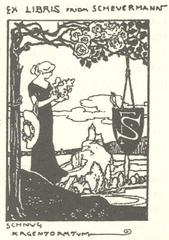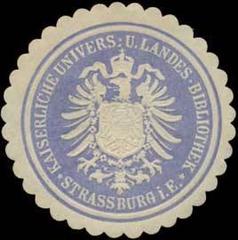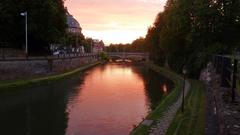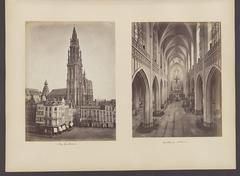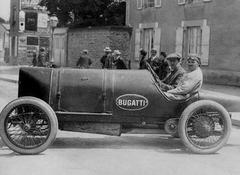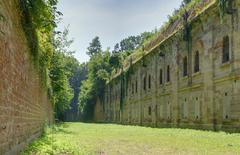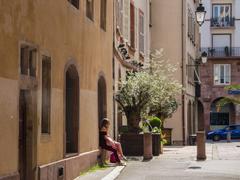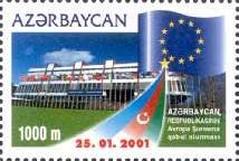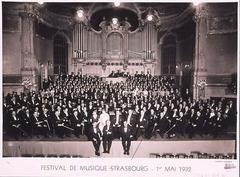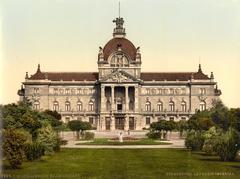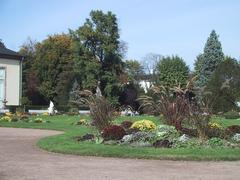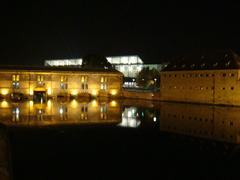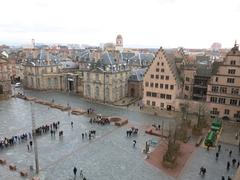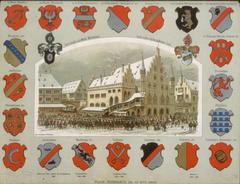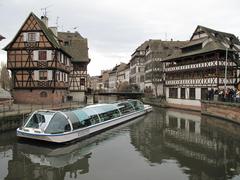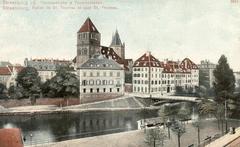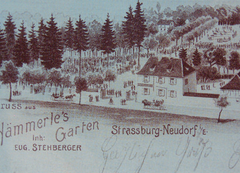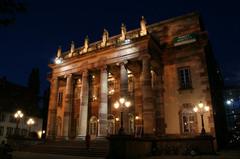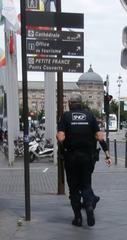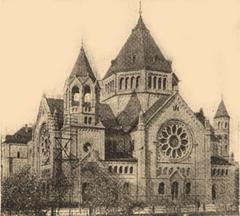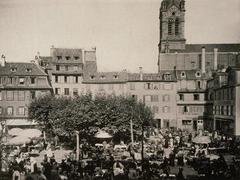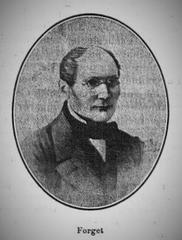Comprehensive Guide to Visiting Musée De L’Œuvre Notre-Dame, Strasbourg, France
Date: 17/08/2024
Introduction
Located in the heart of Strasbourg, France, the Musée de l’Œuvre Notre-Dame stands as a testament to the rich medieval and Renaissance heritage of the Upper Rhine region. Nestled just steps away from the iconic Strasbourg Cathedral, this museum offers visitors an unparalleled journey through time, showcasing art and artifacts that date back to the early Middle Ages. Founded in 1931, the Musée de l’Œuvre Notre-Dame consolidates a diverse array of collections, including original sculptures from the Strasbourg Cathedral, medieval architectural drawings, and works by renowned artists such as Hans Baldung Grien and Sébastien Stoskopff (Wikipedia). This guide aims to provide comprehensive information on the museum’s history, ticket prices, visiting hours, and accessibility features, ensuring that every visitor can make the most of their visit to this cultural gem. Whether you’re a history enthusiast or simply exploring Strasbourg’s historical sites, the Musée de l’Œuvre Notre-Dame offers an enriching experience that delves deep into the region’s artistic and architectural legacy.
Table of Contents
- Introduction
- History of Musée De L’Œuvre Notre-Dame
- Gothic Sculptures and Architectural Drawings
- Renaissance to the 17th Century
- Accessibility and Visitor Services
- Practical Information
- Travel Tips and Nearby Attractions
- FAQ
- Conclusion
History of Musée De L’Œuvre Notre-Dame
Origins and Early History
The origins of the Musée de l’Œuvre Notre-Dame can be traced back to the establishment of the Strasbourg Fondation de l’Œuvre Notre-Dame in 1281. This foundation was initially responsible for the construction and maintenance of the Strasbourg Cathedral. The earliest documentary evidence of the foundation dates back to this period, highlighting its long-standing role in preserving the cathedral’s architectural integrity.
The foundation’s responsibilities included the conservation of building plans and architectural artifacts, such as fragments of the choir screen destroyed in 1681 and original sculptures removed during the French Revolution. These artifacts were later replaced by copies, ensuring the preservation of the cathedral’s historical elements.
The Société pour la Conservation des Monuments Historiques d’Alsace
In the 19th century, the Société pour la Conservation des Monuments Historiques d’Alsace played a crucial role in rescuing valuable components and decorations from churches, cloisters, and chapels across Alsace. This society aimed to preserve altars, statues, vessels, and tapestries that were at risk of destruction or decay. The painting collection of the city, restored by Wilhelm von Bode around 1890, focused on regional masters, including the donation of Hans Baldung’s works.
Establishment of the Museum
The Musée de l’Œuvre Notre-Dame was officially established in 1931, uniting various collections of Upper Rhenish art created before 1681 under one roof. The museum is housed in the half-Gothic, half-Renaissance core building of the Fondation de l’Œuvre Notre-Dame and several early Baroque timber-framed houses surrounding it. This consolidation aimed to provide a comprehensive view of the region’s artistic heritage.
Post-War Reopening and Expansion
After the bombing of Strasbourg during World War II in 1944, the museum underwent significant repairs and reopened in 1956 with an expanded collection. The museum’s collection includes valuable artifacts salvaged from other Strasbourg churches, such as the Temple Neuf, destroyed in 1870, the Saint-Pierre-le-Vieux Church, renovated in 1867, and the Église Sainte-Madeleine, destroyed by fire in 1904. Noteworthy items include Romanesque components from St. Trophimus’ Church in Eschau and stained glass windows from St. Peter and St. Paul’s Church in Wissembourg and Mutzig.
Thematic and Chronological Displays
The museum offers a chronological journey through 40 rooms, showcasing Strasbourg and Upper Rhenish art from the Romanesque period to 1681, the year Strasbourg was integrated into the Kingdom of France. The thematic and chronological displays provide context and depth to the extensive collection, offering visitors a comprehensive understanding of the region’s artistic evolution.
Gothic Sculptures and Architectural Drawings
In the early 20th century, many sculptures from the Strasbourg Cathedral were replaced by copies and the originals were housed in the museum. These Gothic masterpieces are now displayed in the museum’s largest room, the Salle du Jubé, showcasing the exceptional creativity and inventiveness of the cathedral’s construction throughout the 13th century. The museum also features a unique collection of medieval architectural drawings, with two rooms dedicated to these fragile documents. These drawings, linked to the cathedral’s construction, are among the most important in Europe.
Renaissance to the 17th Century
The museum’s collection from the Renaissance to the end of the 17th century includes works by Hans Baldung Grien and Sébastien Stoskopff. This section reflects the intellectual and artistic atmosphere of the period, marked by humanist concerns and the influence of painters and engravers on decorative arts. The furniture from this era features motifs such as shells, garlands, mascarons, putti, and mythological or allegorical themes.
Accessibility and Visitor Services
The Musée de l’Œuvre Notre-Dame is committed to accessibility, offering services for visitors with disabilities. The museum provides wheelchair loans, folding stools, and an elevator to access certain rooms. For hearing-impaired visitors, the museum is equipped with an induction loop amplifier and offers magnetic induction collars for audioguides. Visually impaired visitors can benefit from a tactile audioguided tour. The museum also offers guided tours in multiple languages and audio guides for self-guided exploration.
Practical Information
The museum is located just steps away from the Strasbourg Cathedral, making it easily accessible by foot or public transportation. It is open daily, with the last ticket issued at 17:30 and the museum closing at 18:00. The museum is closed on January 1st, Good Friday, May 1st, November 1st and 11th, and December 25th. Admission fees are €7.5 for adults and €3.5 for reduced tickets. Visitors with a ticket to the cathedral’s platform receive a discount at the museum.
Travel Tips and Nearby Attractions
When visiting the Musée de l’Œuvre Notre-Dame, consider exploring nearby attractions such as the Strasbourg Cathedral, the Kammerzell House, and Petite France. These sites offer additional insights into the rich history and culture of Strasbourg. It’s also recommended to check the museum’s website for any special events or exhibitions that might be taking place during your visit.
FAQ
- What are the Musée de l’Œuvre Notre-Dame visiting hours? The museum is open daily, with the last ticket issued at 17:30 and the museum closing at 18:00.
- How much are the tickets for the Musée de l’Œuvre Notre-Dame? Admission fees are €7.5 for adults and €3.5 for reduced tickets.
- Is the Musée de l’Œuvre Notre-Dame accessible for visitors with disabilities? Yes, the museum offers various services for visitors with disabilities, including wheelchair loans and tactile audioguided tours.
Conclusion
The Musée de l’Œuvre Notre-Dame stands as a testament to Strasbourg’s rich cultural heritage, preserving and showcasing masterpieces of medieval art. Its extensive collection, thematic galleries, and commitment to accessibility make it a must-visit destination for anyone interested in the artistic and religious history of the region. The museum’s close connection to the Strasbourg Cathedral further enhances its significance, offering visitors a comprehensive understanding of the city’s medieval past. For the latest updates, special events, and exhibitions, visitors are encouraged to check the museum’s official website and follow them on social media. By planning ahead and taking advantage of available discounts and guided tours, you can ensure a memorable and enriching visit to the Musée de l’Œuvre Notre-Dame.
References
- Wikipedia. (n.d.). Musée de l’Œuvre Notre-Dame. (Wikipedia)
- Musées Grand Est. (n.d.). Musée de l’Œuvre Notre-Dame. (Musées Grand Est)
- Discover Walks. (n.d.). Top 10 Interesting Facts About Musée de l’Œuvre Notre-Dame. (Discover Walks)
- Enjoy Strasbourg. (n.d.). Visit Musée de l’Œuvre Notre-Dame. (Enjoy Strasbourg)
- Musees Strasbourg. (n.d.). Museum of the Œuvre Notre-Dame. (Musees Strasbourg)
